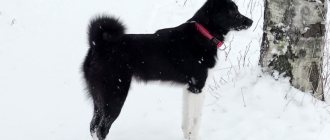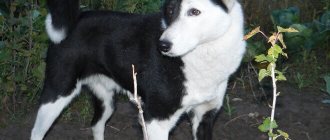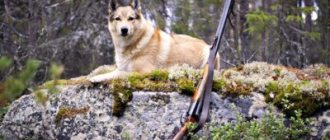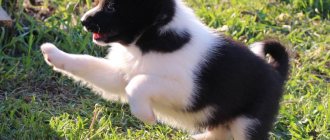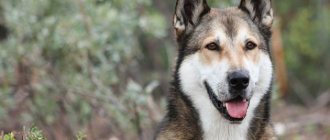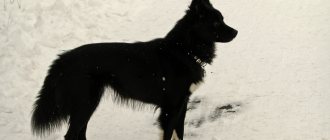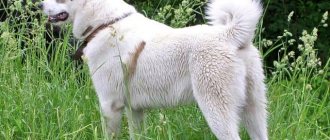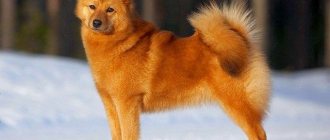| Origin | Russia |
| Usage | hunting dog |
| Color | black and white in any ratio, including monochromatic |
| Dimensions | 48-58 cm at the withers |
| Lifespan | up to 15 years |
Laikas are one of the most purebred dog breeds, thanks to natural selection. There are several species of northern hunting dogs, of which the Russian-European Laika is the largest. Many sources apply the abbreviation REL to this name. It is also actively used by hunters and breeders. The so-called Western European Laikas include not only the Russian variety, but also the Finnish and several Norwegian breeds.
Origin story
Laikas are one of the most ancient dogs that developed independently, without human intervention. Animals were popular not only in the north, but also participated in game hunting in the middle zone, as evidenced by frescoes from the times of Kievan Rus.
Yes
11.11%
While I'm thinking
33.33%
Has already!
55.56%
They tried to breed pointy-eared northern huskies at the end of the 19th century, and in the early 20s. 20th century The dogs appeared at the First All-Union Dog Show under the names Cheremis and Zyryans. These dogs represented a fairly diverse group, which subsequently became the basis for future breeds of the Karelian-Finnish, Russian-European, Western and Eastern Siberian Laika.
The official canine history of REL began relatively recently, in 1947. Scientists Kuhn and Shereshevsky developed a plan and began to breed four separate varieties of the Western European husky. Selection was rapid and was based on the dogs' conformation. The basis of the Russian-European type was a pair of a purebred West Siberian husky and a hybrid animal with an attractive black and white color.
The first REL standard was approved in 1952. Over the course of one twenty years, several breeding lines were formed, and the number of representatives of the new breed grew to a thousand. The standard of appearance of Russian Laikas became stricter and was fully formed by 1980, when it was adopted by the International Canine Federation.
Breed standard
The latest FCI breed standard has been in effect since 2011, defining the following characteristics of REL:
- The shape of the husky's body is close to a square.
- The pronounced withers extend into a straight, strong back with a short convex loin and a wide croup, which is located with some slope.
- The chest extends to the level of the elbows with good depth.
- The belly of the Russian European Laika is very tucked up.
- The shape of REL's head is triangular.
- The muzzle makes up a little less than half of the head.
- The wide skull of the Russian-European Laika has a pronounced nape and a smooth transition to the muzzle, which looks brighter thanks to the well-protruding brow ridges.
- The nose of European huskies is always black and small.
- The lips are set tightly against a strong jaw with a scissor bite of a full set of large teeth.
- The cheekbones of huskies have a pronounced sculpture.
- Brown eyes are set slantingly in the middle position.
- The ears, one of the most important characteristics of the compact-sized REL breed, are shaped like a sharp triangle, set high and pointing straight up.
- The lean, muscular legs end in oval paws with high arches and tucked toes.
- The tail has the shape of a ring or a sickle; it is not necessarily thrown over the back, as it can also be pressed to the thigh.
The coat of huskies is double, the outer hairs are straight and rough to the touch, and the undercoat is soft, very dense and padded. There is a slightly elongated collar on REL's neck, and pants without fringes on the hind legs. The color can only be black and white in any ratio, including solid color.
Breed standard and description
Height at withers: males 52-58 cm, females 48-54 cm; Weight: 18-23 kg (proportional to height).
- Typical colors: black and white, white and black, solid white or black.
- Eye color: dark brown or brown.
- Nose color: black.
- General appearance: A medium sized, square dog with erect ears, a wedge-shaped muzzle and a curled tail.
Character
Laikas actively demonstrate their strong and independent character. Such a dog is suitable only for a trained, self-confident owner. Used by hunters for centuries, RELs have been given the ability to be fearless, assertive and fearless. They independently make the right decisions during the rutting season, but at the same time do not get excited, but remain calm and balanced.
The character of the Russian-European Laika deteriorates only in the absence of education or improper training.
The breed's willfulness often manifests itself in the form of unreasonable barking and a tendency to run away. REL must be carefully trained, walked on a leash and controlled during the walk. A properly raised dog quickly becomes attached to the owner and remains devoted to him, experiencing a neutral attitude towards the family rather than sincere love.
Education, training, grooming
The training of the Russian-European husky is based on helping the animal become a professional getter of forest and field trophies. The remaining service commands are discarded. At the same time, with a pet living in urban realities, you can take a UGS (controlled city dog) course. True, according to experienced hunters, such “education” does not have the best effect on the instincts of the breed. As a result, dogs trained in service commands perform much worse.
You can groom your future hunting husky from as early as three months, regardless of the time of year. Start with short walks in the forest and try not to make noise so that the puppy can listen to new sounds. The grooming technique also depends on what type of animal and game is to be hunted. For example, to work with waterfowl, you need to teach your puppy to overcome his fear of bodies of water. It is better to hunt the Russian-European husky hazel grouse in the fall and in those forests where young feathered animals definitely live.
Important: Russian-European huskies, who live in city apartments for years and go hunting only once a season, may lose their keen sense of smell. Usually the sense of smell is restored during work, but this does not happen immediately.
Mandatory skills for hunting huskies: walking next to the owner, willingness to sit down and give an object on command, including from the water. Breeders recommend organizing the training process with the help of additional equipment: a 20-meter leash with a carabiner, a plain whistle, a carrier (a piece of wood or a soft fabric toy). It is acceptable to use a thin rod when practicing the “No!” command. Traditional scheme: a dog caught picking up food from the ground is held at the “crime scene” and whipped sharply, but not too hard, with a vine. If you don’t have a rod at hand, it’s useful to pull the leash and voice the command. At the same time, it is strictly forbidden to hit a Russian-European husky with your hand or leash.
By the age of six months, a Russian-European Laika puppy is usually socialized: he knows his name and responds to it, is accustomed to walking on a leash, and has fit into the hierarchical system of the family in which he lives. At 6 months the animal can be prepared for hunting and trained. The first command to learn is “Near!” The owner takes the Russian-European husky outside, gives an order, patting himself on the thigh and at the same time pulling the puppy towards him by the leash. The strap is then gently released and the pet receives a rewarding pat or treat. By the way, for the latter it is better to buy a belt bag. Over time, the husky will understand where the owner hides the treats and will try to earn them.
When the Russian-European husky learns to walk side by side, start practicing the “Sit!” command. Everything is traditional here: after the order, the pet is gently pressed on the sacrum, forcing it to sit down on its hind legs. At the same time, the puppy is taught to give diarrhea correctly. The scheme is simple: shake a cloth stuffed animal in front of the animal’s nose. When the pet begins to grab the object with its teeth, throw it forward with the command “Give!”, and after the husky picks up the stuffed animal, gently take it away, rewarding the puppy with a treat.
If you plan to go waterfowling, teach your Russian-European Laika to swim. Only without extremes: throwing a puppy into the water, as home-grown “pros” do, is a harmful and empty activity that will provoke hydrophobia in the animal and nothing else. It is better to start by crossing shallow reservoirs (the owner goes first, followed by the puppy) and only in the warm season, since dogs also need time to get used to and harden. As for baiting large animals, it can be done at stations and with animals at least 1 year old. And of course, take into account the individual characteristics of your own pet: some huskies are not vicious enough for such an activity and are often frightened by potential prey that is larger than them.
Application
The standard description of the breed characterizes REL exclusively as a hunting dog for wide use. Dogs calmly and purposefully chase prey for a long time, regardless of weather conditions. A developed reaction helps huskies coordinate movements alone and as part of a pack. Dogs hunt down prey using barking and cunning.
REL aggression is shown only towards the object of hunting and never towards people.
However, dogs are wary of strangers, which makes the Russian-European, East Siberian and West Siberian Laika excellent guards. When in danger, dogs raise their voices, but do not openly attack. If desired, increased anger and wariness can be developed in an animal, but only through the authority of the owner, and not through physical punishment. By accepting the training well, REL is able to learn how to apprehend offenders.
Socialization
The nature of the European husky is not suitable for keeping it in a family with small children. The dog will play with them with pleasure and show moderate affection, but will not obey them. For a northern dog, obedience is regulated only by the authority of its owner.
Socialization of REL must begin as early as possible so that the husky feels good with people and does not show nervousness and wariness.
The breed is wary of other dogs, as it acutely feels the need to defend its territory. Jealousy and the demands of a strict hierarchy make maintaining several RELs together difficult, but quite possible. The main thing is that a clearly defined leader stands out among the pack. The Russian-European husky does not get along with other animals, perceiving them exclusively as prey or a competitor.
How to choose a puppy
When choosing a future pet among puppies, the photo is not a fundamental factor. As a guideline for REL, it is necessary to consider:
- reputation of the nursery;
- compliance with the breed standard;
- working qualities of the puppy's parents;
- active behavior;
- healthy appearance;
- The coat is uniform, without bald spots.
All varieties of Western European husky are widespread in the northern regions of the country. In Russia and the CIS you can find an official REL breeder and there is no need to buy a puppy without documents. Most often, healthy babies are chosen based on color. The coat color of the Russian-European Laika is most often spotted, but can also be solid. White puppies are valued much more, as the dominant black tone gradually replaces the light one.
Features of the breed, what distinguishes it from other breeds
Among the main characteristics of the breed are a strong character, passion for play, and dynamism, which are combined with balanced behavior. The appearance of the husky reflects strength and power, which are not inherent in small breed dogs.
It is impossible not to note the ease of care and nutrition. Some animals have fur that constantly mats, even with regular brushing. Some dogs experience problems with food and lack of appetite, which cannot be said about the Russian-European Laika.
Features of maintenance and care
Working Russian-European Laikas are not suitable for keeping in a city apartment. Walking in the park, jogging or walking on a leash is not enough for dogs. A private house in a rural area is ideal for keeping dogs. Large open areas will help the husky to splash out all the accumulated energy. Tall growth will not allow the northern woman to catch rats, but REL may well bring a beaver or badger from a walk. Hunting will give the dog the necessary exercise and develop working qualities that are an integral part of the breed standard.
In the photo, the Laika seems like a cheerful, domestic dog, but this is not entirely true. She prefers life in a spacious enclosure or in a booth in a fenced-in yard than in cramped living rooms. A collar with a GPS chip will not hurt a Russian-European hunter, especially if she is kept free.
The breed is completely undemanding and does not require daily care and attention. For REL, regular hygiene procedures, combing, a balanced diet and veterinary measures are sufficient.
Grooming
The breed standard requires a very dense undercoat that needs to be brushed every 3-4 days. Shedding significantly increases the amount of fur shed, and grooming is best done daily. This procedure speeds up the process of wool replacement and prevents clumping and tangle formation.
Bathing is carried out only when the coat is heavily soiled, but not more than once a month. If REL is often in the forest and comes into contact with game, then you need to periodically inspect the skin for ticks and other insects.
Russian Laikas require weekly ear care, which is cleaned and rinsed. When the claws do not grind down on their own, they can be carefully trimmed.
Walk
The nature of the Russian-European Laika requires a long walk, accompanied by physical exercise or games. A good sense of smell and curiosity carry representatives of the breed forward, often to dangerous places. Walk the dog on a leash, and use a muzzle and harness in crowded places.
REL must spend at least 2 hours outside in the morning and evening.
Living in a private home or going out into nature allows you to walk your husky freely, but this must be done with caution. A beautiful black and white palette does not help you quickly see a dog against the backdrop of, for example, a snowy forest, so you need to periodically call the animal to you. REL will not listen to anyone other than the owner, so you cannot trust strangers to walk.
Feeding
Large European huskies are not particularly demanding when it comes to their diet, however, they should not be given food from the table. Dry or natural food must be balanced and based on animal proteins.
For meat products, you should give preference to beef over fatty pork and chicken, removing the tubular bones. The REL diet includes offal, sea fish pulp, cereals, and vegetables.
The dry mix should be aimed at medium-sized active dogs and at least premium. Food is provided to the husky according to its age:
- 6 times a day starting with complementary foods;
- 4 times, starting from 2 months;
- three times after six months;
- twice upon reaching 10 months of life.
Breed characteristics and character
The breed is classified as a hunting breed. The ancestors of the Russian-European Laika include the Arkhangelsk, Karelian, Kostroma, Mari and West Siberian Laika. The history of this animal dates back to the second half of the last century. It took only about 20 years for this dog to become the result of crossbreeding.
The appearance of black and white Russian-European huskies is associated with such surnames as Kuhn and Shershevsky. Already in the 75th year of the twentieth century, there were about 1000 representatives of the breed. The requirements for the standard have been tightened.
This time is the peak of popularity of Russian-European Laikas. After the 80s, they began to be replaced by other breeds, and in the 90s, preference was given to small decorative dogs. During the crisis years, it was easier to feed these pets. Currently, the popularity of this breed is growing again.
The main function of the dog is as a gun dog, and hunting with the Russian-European Laika is the main business of the owner. Therefore, those who get a dog as a home companion are fundamentally wrong.
She is not suited to the role of the family pet. More precisely, the dog is not ready to be awarded only this function. A tough, stubborn disposition takes its toll. The best owner would be an experienced breeder who lives outside the city and is keen on hunting.
In addition to being a hunter, the Laika can work as a watchman and helps law enforcement agencies. In terms of training, it is, of course, inferior to the German Shepherd, but if you train it well for a specific game, you can achieve considerable success. There are often cases when these animals even went after a bear and were very successful.
The four-legged friend has fearlessness and intelligence, preferring to act based on the situation. If a dog behaves aggressively with animals, demonstrating dominance, then with people it is more restrained.
Health
Russian Laikas are a breed with good health and well-developed immunity. This is due to natural formation and a large number of individuals for mating. REL live up to 13-15 years, but do not die of old age as often as they die while hunting. This happens not only due to injuries, but also from diseases received from game. Dogs need to be vaccinated regularly and seen by a veterinarian.
What distinguishes the Russian-European Laika from other breeds is not so much immunity as a high degree of endurance and rapid adaptation to changing living conditions or climate. Poor nutrition, excess weight and violation of living conditions contribute to the appearance of diseases.
Diseases
Thanks to a long history and natural selection, dogs have become resistant to most dangerous diseases. REL rarely have hereditary pathologies, but there is a risk of manifestation:
- epilepsy;
- stones in the kidneys and ducts;
- loss of voice.
Any variety of Western European husky can be born with congenital hip dysplasia, but the risk of this pathology is extremely low.
Vaccinations
The main reason for the much-needed vaccination for Russian Laikas is the close contact with wild animals. Every year REL is vaccinated against:
- rabies;
- carnivore plague;
- parvovirus enteritis;
- coronavirus;
- parainfluenza;
- hepadnavirus;
- leptospirosis;
- trichophytosis.
At the age of 2 months, the puppy is vaccinated for the first time, together with repeated vaccination after 21 days. The third vaccination is required REL at the age of six months, which coincides with the end of the change of teeth. At 12 months they are vaccinated again with a complex preparation, which is then used annually.
Pros and cons of the breed
Advantages and disadvantages of the breed:
| pros | Minuses |
| Good health | Walks should be long |
| Easy care | Often stubborn |
| Excellent Hunter | Chases cats and other animals |
With proper upbringing, this characteristic can be corrected.
Mating
Female Russian-European Laikas have a six-month estrus period, which occurs at the end of winter and summer. Early mating of REL negatively affects not only the offspring, but also the health of the parents. The optimal age for the first mating is 18 months, which corresponds to 3 heats in a row. The Russian Laika is allowed to breed only after successfully passing the tests and in full compliance with the breed standard.
To choose a suitable partner, you should contact a kennel or a cynologist who provides permission for mating.
Before introducing dogs, you should find out everything about REL’s health, check documents and exclude family ties.
Mating is carried out at the dog’s home, giving the dogs time to get to know each other. There is no need to control the mating process, the couple can handle it themselves. But the owners need to be present nearby to ensure a successful outcome. To be sure, re-mating is carried out after 12-36 hours.
How much do puppies cost?
The average price of REL puppies depends on many factors. Among them:
- degree of compliance with the breed standard;
- pedigree and achievements of parents;
- health status;
- gender;
- attractive color;
- geography of the nursery.
You can find out how much the baby you like is worth from the nearest breeder, but most likely the price will be in the range of 15-30 thousand rubles. A cheap puppy without a pedigree or with an incomplete set of documents is presumably a mixed breed or the result of crossing huskies that are not officially allowed for mating.
Nurseries
You can buy purebred Russian-European Laika puppies in Chelyabinsk, Smolensk and Kolomna, as well as in Belarus. In the Moscow region there is a nursery “Bombor” (https://dog.pet2me.com), which is located in the city of Yegoryevsk. They mainly breed Caucasian Shepherd dogs there, but there is also a REL breeding line.
Among the large number of varieties of huskies, the Russian-European one stands out for its extraordinary appearance and the strong character of a real hunter. REL is suitable as a companion and assistant for an energetic owner to be kept in a private house with a large territory and the possibility of going out into nature.
